Many expected the leap from the Championship to the Premier League to be too much for Luton Town, but of the three promoted teams, they now look likeliest to stay up.
After defying virtually everyone’s expectations in earning promotion from the Championship last season, Luton Town’s first top-flight campaign in over 30 years looked likely to be long and harsh, particularly following back-to-back defeats in their two opening games.
They were comfortably beaten 4-1 by Brighton and then 3-0 by Chelsea. Although not the most straightforward of opposition to begin a season against, many would’ve felt they were results that confirmed the gulf between Rob Edwards’ men and the Premier League.
Another two losses followed, and despite the significant amount of time remaining, you’d have done well to find many neutrals not writing them off. It was shaping up to be a race to the bottom between them and their fellow promoted sides, Sheffield United and Burnley.
But gradually, Luton showed signs of adaptation and positive results have rarely been far from their grasp, losing by more than one goal just twice in all competitions since that defeat at Stamford Bridge in August.
It’s the past two months that seem to have transformed Luton’s season, though. They went into December with just two Premier League wins to show for their efforts, but since then have tallied three victories, pushed Manchester City, Chelsea and Arsenal close in slender defeats, and nearly beat Newcastle United at St James’ Park at the weekend.
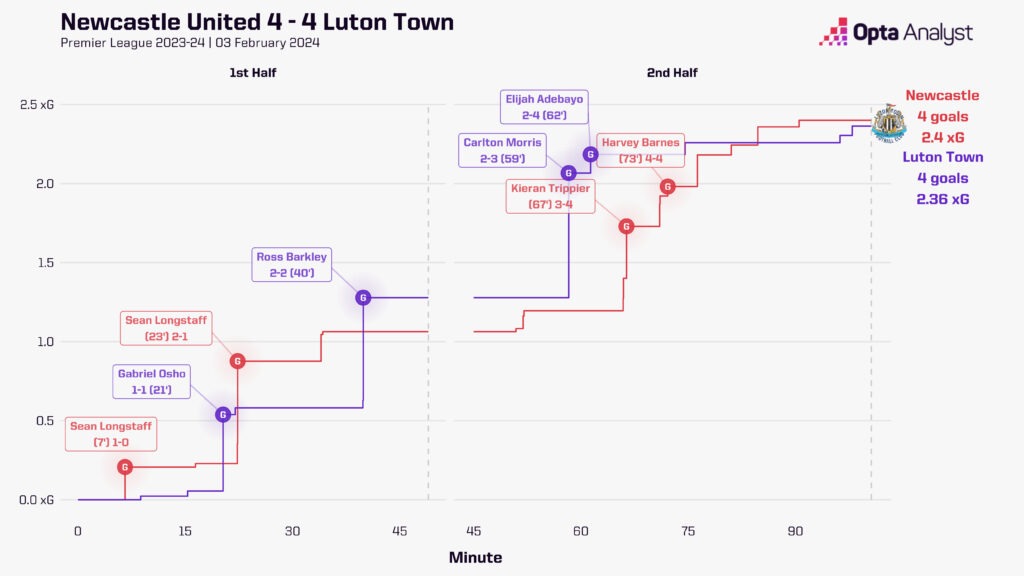
Saturday’s thrilling 4-4 draw with Newcastle came four days on from a stunning 4-0 hammering of Brighton. Not only was it a sweet act of revenge for earlier in the season, but it was also poignant in highlighting how far they’d come since the previous meeting, going from arguably the favourites for relegation to one of the Premier League’s form teams.
Over their last six games, Luton have taken 11 points. That’s a figure only Liverpool, Wolves (both 13) and Manchester City (15 from five matches) can better over the same period, and one more than Arsenal and Manchester United. It’s a far cry from a run of one win in their first 12 league games this season.
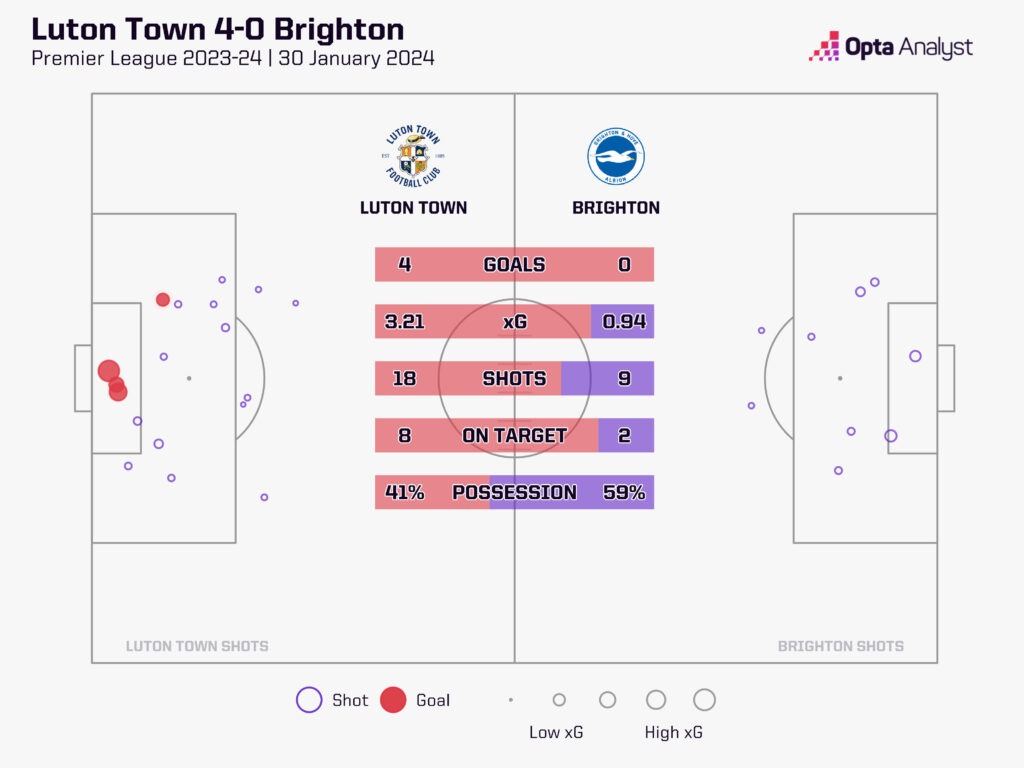
“I think we’ve had to grow, learn and change as the season’s gone on,” Edwards said after the thriller in Newcastle. “Not [changed] my principles or what we believe in, but just tactically we’ve been able to be a bit more aggressive because of the attributes the players have got.”
This is arguably most notable in their pressing. Before December 1, Luton averaged 37.3 pressures – defined as a defending team’s player approaching the player in possession with the aim of winning the ball or limiting passing options – in the final third per game, which was the third lowest in the division. Since 1 December, however, they’ve recorded 60.4 pressures in the final third per game, third only to Everton (77.9) and Manchester City (62.8). It’s not like they’ve played lots of teams that sit back in that time, either, having faced Arsenal, Chelsea, City and Newcastle twice.
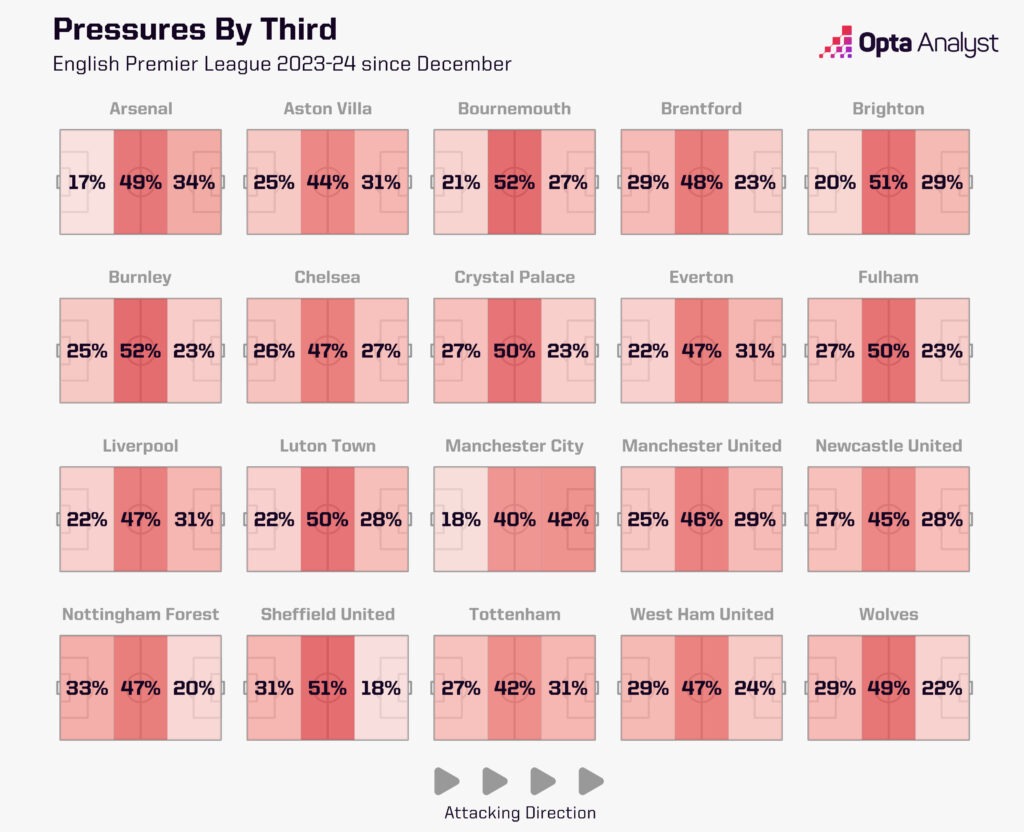
Furthermore, 28% of their total pressures since the start of December have occurred in the attacking third, as opposed to 19% beforehand, so not only are they generally working with greater intensity when attempting to win the ball back, there’s a concerted effort to focus that urgency higher up the pitch.
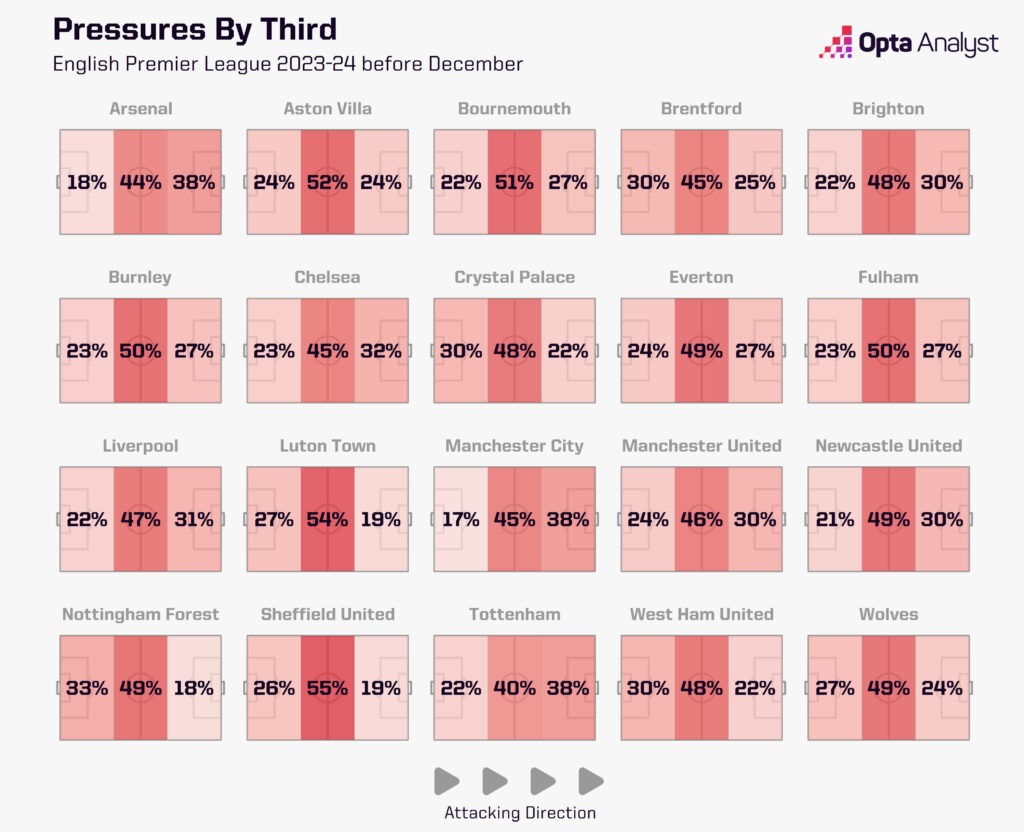
A good example of how this has paid dividends is their first goal in the recent win over Brighton. Right from kick-off Luton were in the faces of their opponents and won the ball back within eight seconds; they swiftly turned that into the first attack of the game and scored through Elijah Adebayo 11 seconds later to set the tone for the match.
Their attacking numbers have also improved considerably. Luton’s shot frequency hasn’t changed, remaining at 11.4 per game on average, but since the start of December they’ve managed 4.8 on target each match, a significant uptick from 2.7 before. Combine this with an increase in their expected goals (xG) output per game (0.96 pre-December, 1.27 since) and it paints a picture of a team that’s steadily become more attuned to the demands of the league and thus making smarter decisions in the final third.
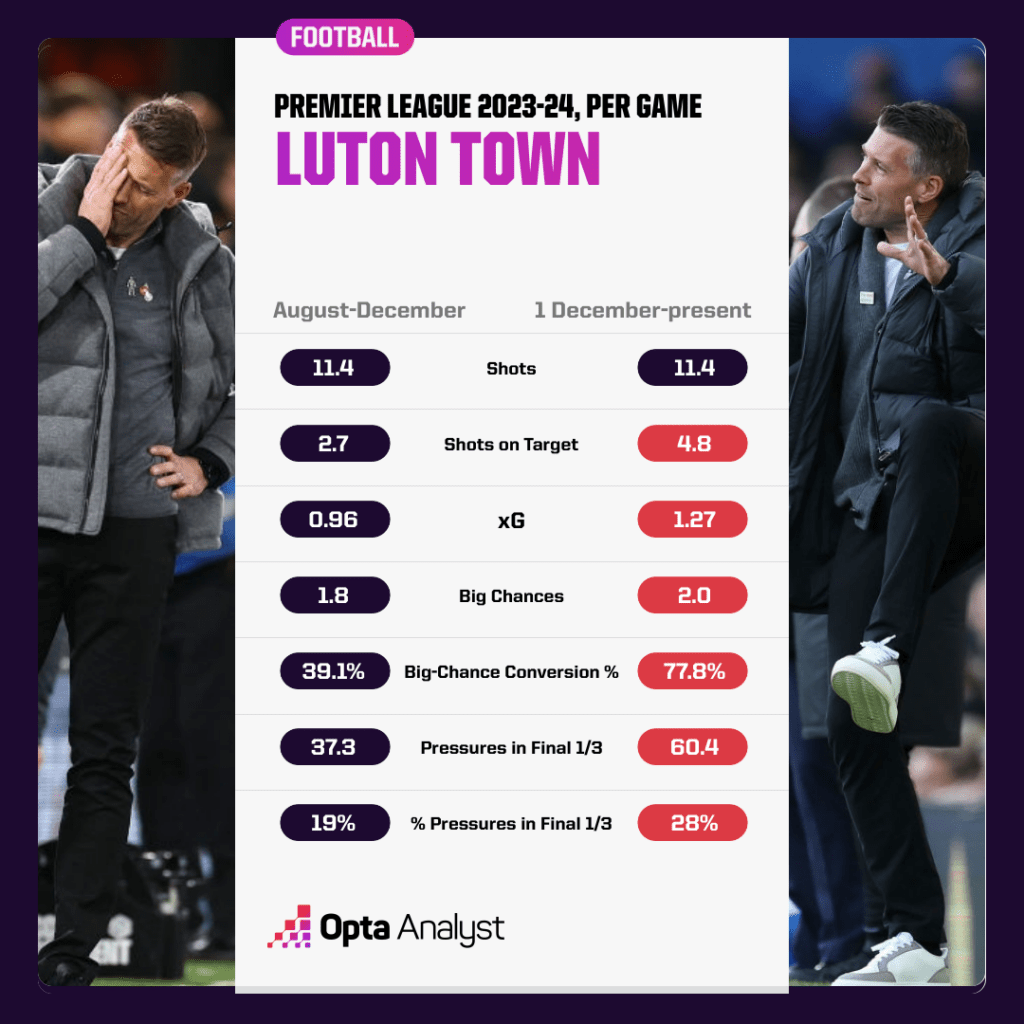
This is also reflected in how clinical they’ve been over the past two months, with no team scoring more “big chances” than their 14 – that’s from a possible 18, giving them a big-chance conversion rate (77.8%) that is far better than any other team in the league since 1 December.
A key component of Luton’s chance creation has been their width and the abilities of their wide players, with no team using wing-backs as opposed to full-backs for a greater proportion of time than them this term (88%). While the rapid Chiedozie Ogbene – nominally a winger – appears to have made the right wing-back berth his own in recent weeks, Alfie Doughty has been a mainstay on the left and arguably Luton’s most-celebrated player this season.
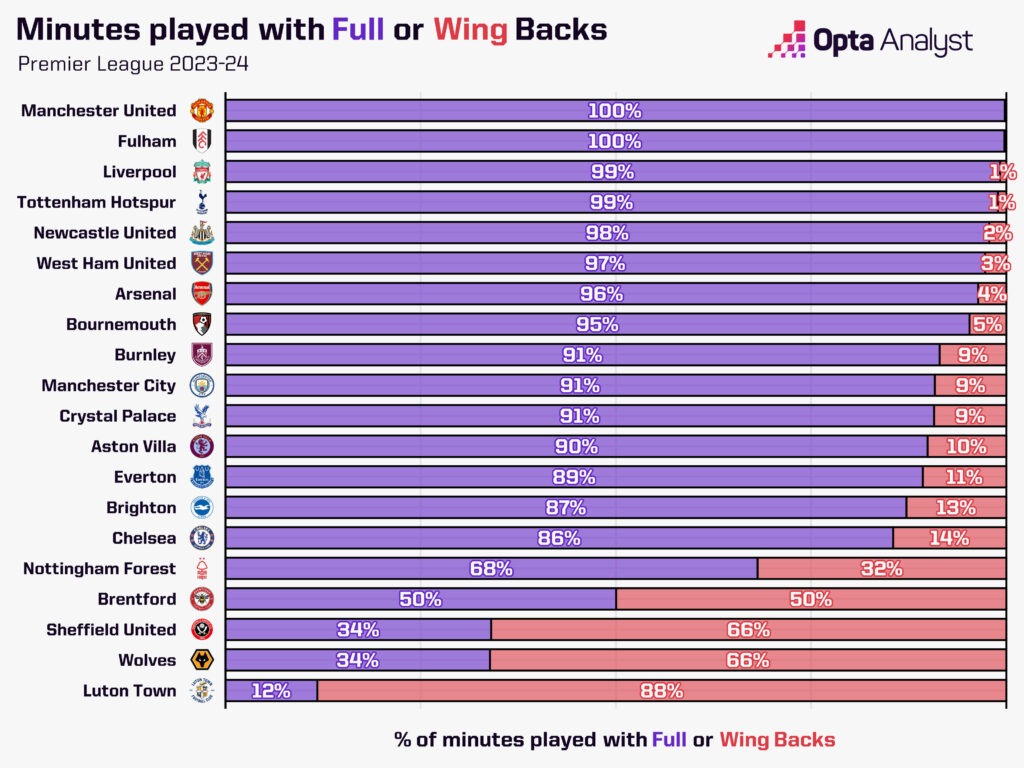
His deliveries, both in open play and at set-pieces, have been a regular feature, with Doughty’s 38 chances created 11 more than any other Luton player. Fourteen have come in open play, putting him behind only the reinvigorated Ross Barkley (21) and Ogbene (19). The mentality of Luton’s wide players is also a good example of the aggressive positivity Edwards spoke about at the weekend, with their wing-backs being the most advanced wide defenders in the league this season, as the graphic below highlights.
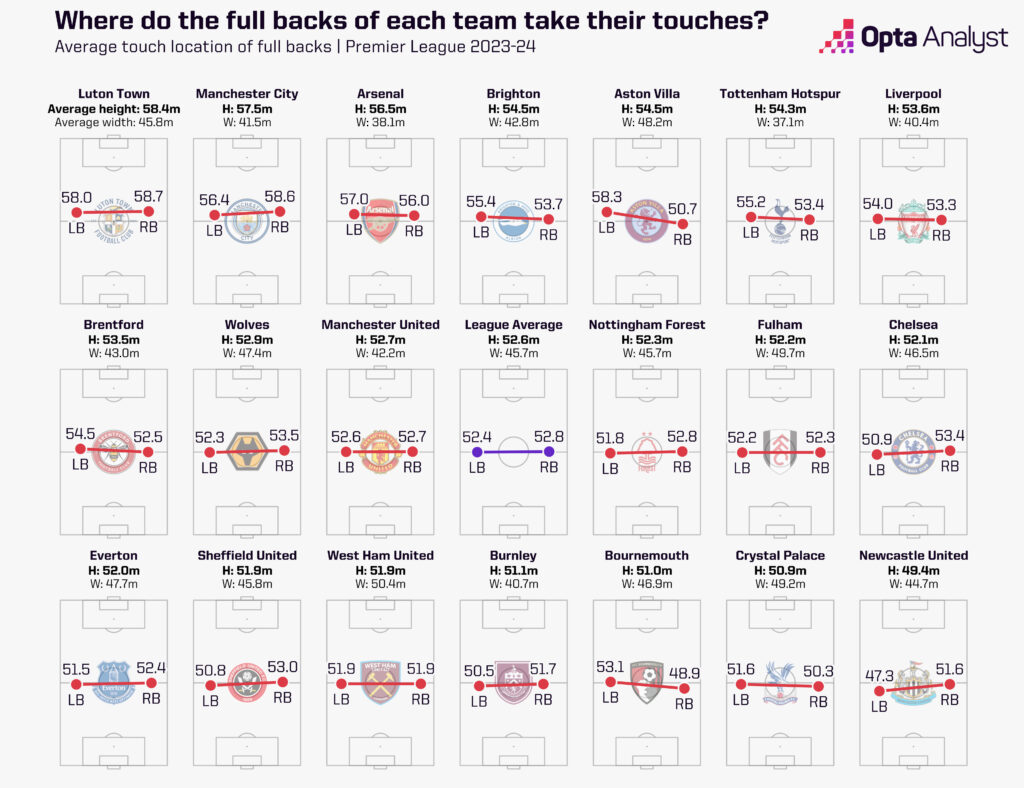
Nevertheless, there has been something of a shift in the way Luton play. Before December, their 203 open-play crosses was the most in the Premier League; their 111 since is only more than seven teams, suggesting a greater degree of subtlety in how they attack.
This has coincided with Barkley finding his feet, flourishing to an extent that talk of an England recall – having not played for his country since 2019 – is gaining traction. Although he was robbed of the ball in the build-up to Newcastle’s late equaliser at the weekend, the former Chelsea midfielder was otherwise excellent again; it was his free-kick that caused havoc for Luton’s first goal, he then scored their second having played a vital role in the build-up, and he set up Adebayo for number four.
Over the past two months, he’s been involved in 47 shot-ending open-play sequences, one shy of double any other Luton player in that time and 27 more than from August until December, evidence of him gradually getting sharper following a largely underwhelming few years.
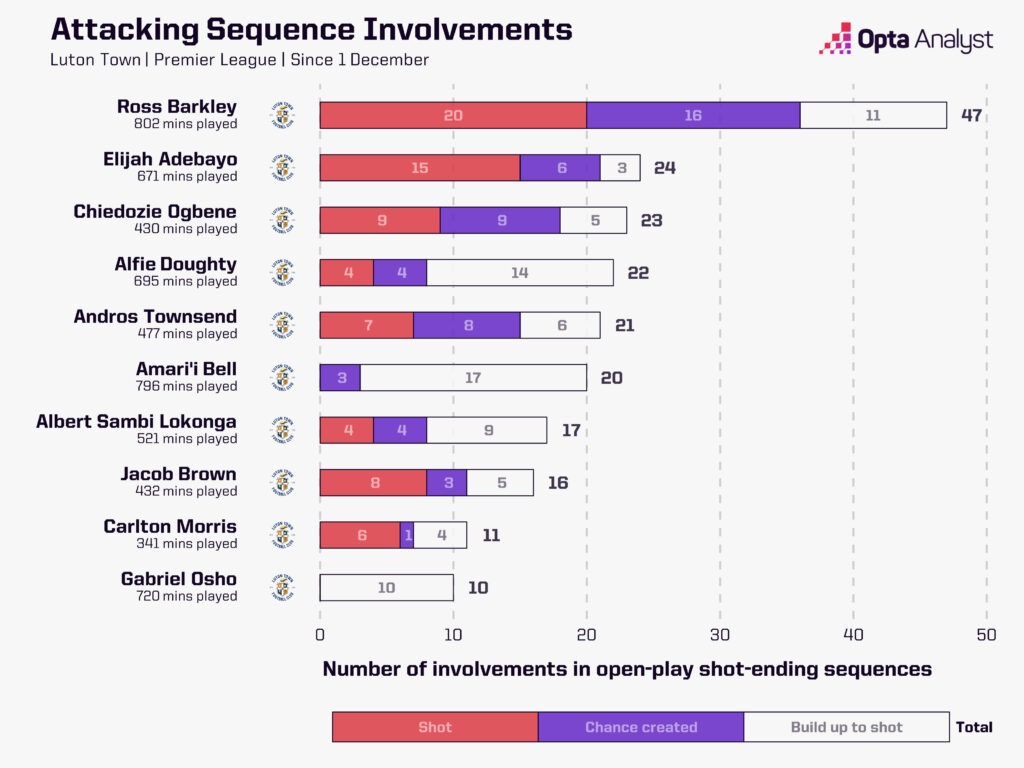
Goalkeeper Thomas Kaminski also deserves praise for his reliability between the posts. According to Opta’s expected goals on target (xGOT) conceded model, Kaminski has let in 5.9 goals fewer than he’d be expected to based on the quality of shots faced, a better record than any other Premier League goalkeeper this term and evidence of some fine shot-stopping.
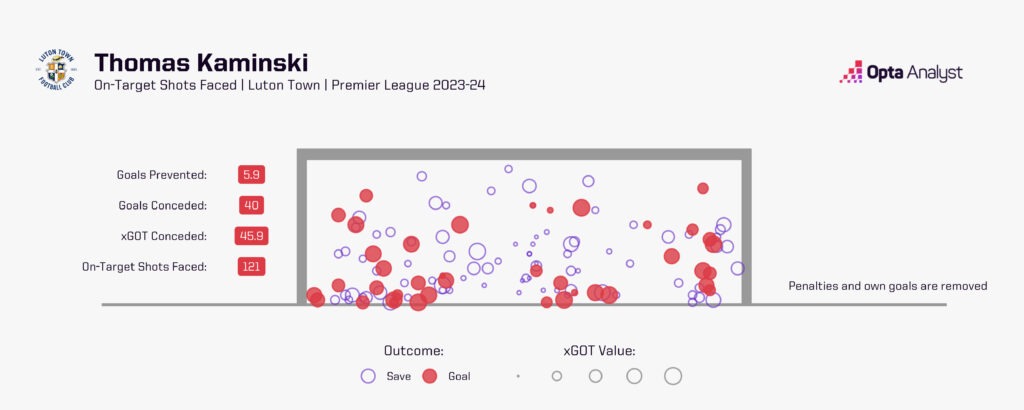
However, quirks like that also highlight a degree of good fortune on Luton’s part. Not only have they needed their goalkeeper to perform way above the average, their finishing efficiency – as alluded to earlier – is out of the ordinary.
Across the whole season, only three teams have had lower-quality non-penalty shots on average than Luton in the Premier League (Burnley, Sheffield United and Crystal Palace). Their xG per non-penalty shot is 0.096, which essentially means the average chance Luton create you’d expect to be converted 9.6% of the time. However, their shot conversion rate from these efforts is 11.7%; only Tottenham (+2.2%) and City (+2.5%) have converted non-penalty shots above their expected rate to a greater degree than Luton (+2.1%).
This is obviously a good thing; there’s nothing bad about scoring. But, it’s also a warning that they could potentially just be on a hot streak, one that ultimately fizzles out before they can build a significant gulf between themselves and the relegation zone.
Is Luton’s recent form just a flash in the pan, or is it a natural sign of progression, improvement and increased self-belief? That remains to be seen. Either way, Edwards will want to nip any signs of arrogance in the bud; sure, they’ve done brilliantly over the past six weeks or so to propel themselves out of the bottom three, accumulating 20 points from 22 games and giving themselves a fighting chance of retaining top-flight status, but they’re hardly bulletproof; 15 promoted teams have still gone on to be relegated back to the second tier from the Premier League after earning 20 points or more from their first 22 matches, six of whom had exactly 20.
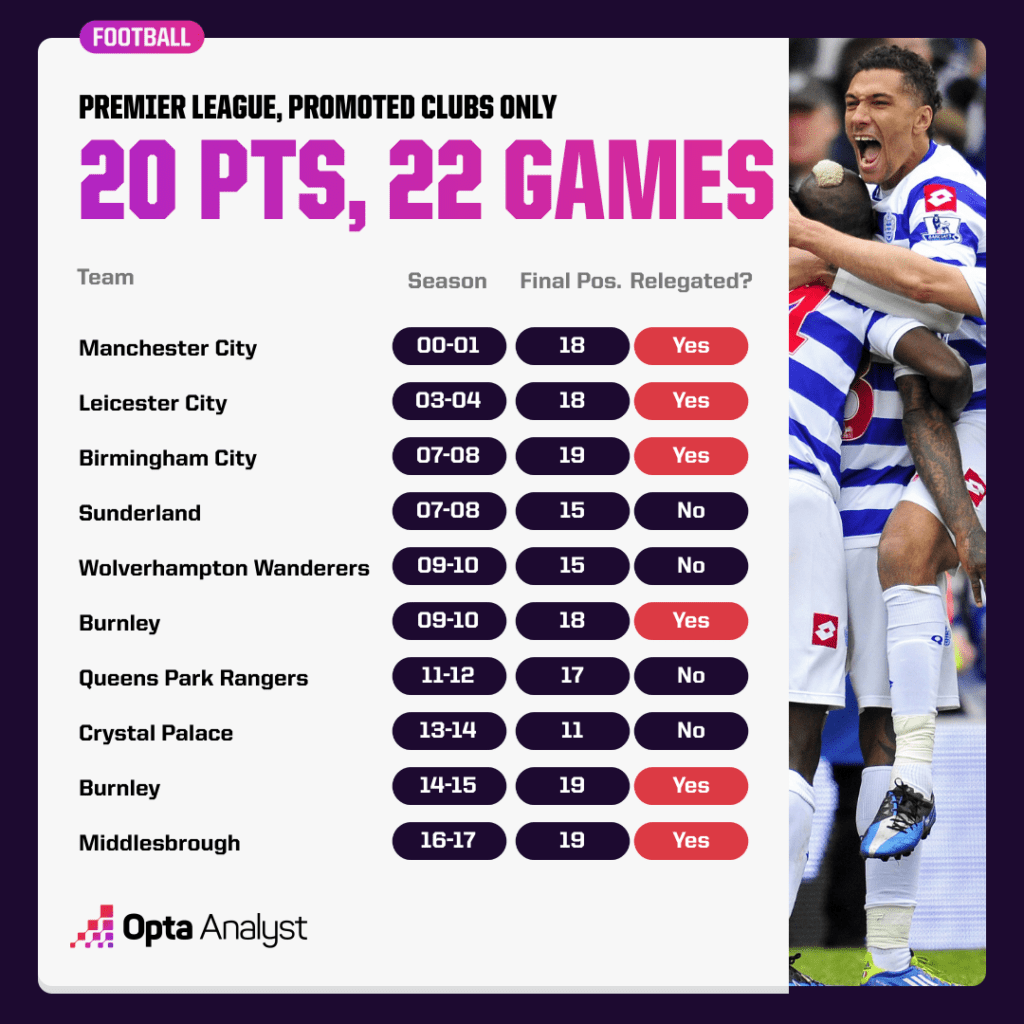
Establishing a team in the Premier League isn’t an easy one, particularly for the promoted clubs, and a long path remains ahead of Luton that doesn’t just end with the conclusion of 2023-24; after that comes the infamous threat of the so-called ‘second-season syndrome’ that’s claimed so many who’d previously promised much.
Clearly, though, Edwards and Luton are giving it a better crack than most anticipated, with the weekend’s results bringing their relegation probability down to a season-low 32.6%, according to the Opta supercomputer. Fans should absolutely enjoy as much of it as they can, for as long they can.
“The players deserve all the credit because they’re doing it in the hardest league there is,” Edwards said on Saturday. “It makes me really proud.”
So he should be. Their improvement has been significant and has them set up to potentially confound a few more doubters before the season’s end.
Enjoy this? Subscribe to our football newsletter to receive exclusive weekly content. You should also follow our social accounts over on X, Instagram, TikTok and Facebook.
